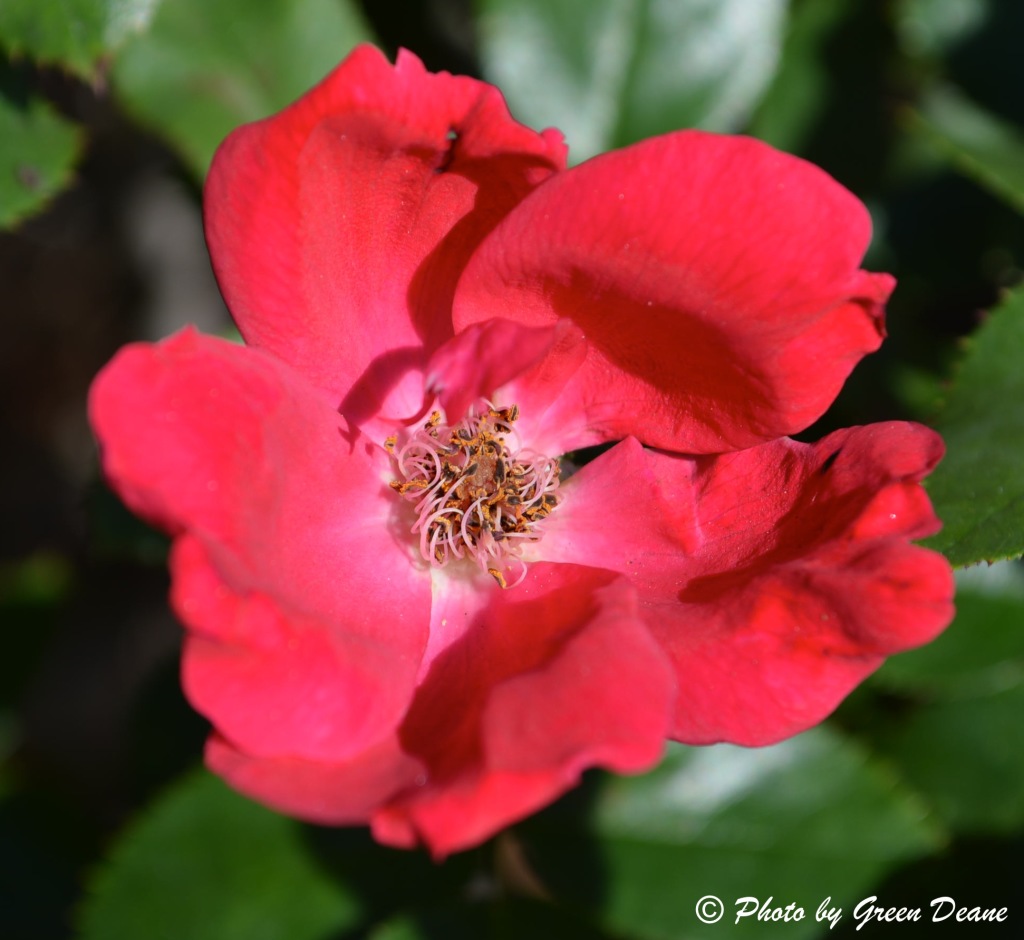
Roses have the classic five petals. Photo by Green Deane
I’m not sure I found wild roses or they found me.
Growing up in Maine the local soil was usually either ground-up glacial sand or clay which is decomposed feldspar, or ledge. Not much of a choice if you’re a plant. We had sand, over ledge with a thin veneer of topsoil. And in that sand grew wild roses, Rosa rugosa. Long and stringy with pink petals and bright yellow centers and thorns, lots of thorns. I do recall, however, having a difficult time as a kid reconciling that the wild roses in the field behind the house were related to the roses in flower shops. They didn’t look like each other that much but the wild roses did have a hint of rose aroma. I grew more interested in roses when I learned the rose seed hairs were the original itching powder.
If you’ve read my series on Edible Flowers you also know that I once delivered flowers. I had been accepted to law school and needed a job to tie me over until classes started so I delivered flowers. What an eye-opening experience! I went in thinking it had to be a wonderful job because you were delivering joy everywhere… wrong… oh so wrong. It was amazing how many women refused flower deliveries, or took them with a huge air of suspicion. And of course, there were all those deliveries to funeral homes. But most interesting were the roses. They were big and beautiful and absolutely without any aroma. None. They were bred for size and color and in the process the aroma disappeared. We had to spray the roses with artificial rose scent just before delivery, every delivery. AND… you did not spray the roses in the delivery van or get any spray on your or you’d smell intensely like roses for days, literally. Not surprisingly we carried several different spray-on scents so the grand and lovely hybrids of various genera would smell like the original thing. Rose, however, was the most powerful and long-lasting. (By the way, some flower arrangements that were not accepted were kept so they would wilt and die only to be sold for 40th birthday deliveries.)
Let’s start at the top of the rose and work our way down. Petal flavor depends on the type, color and conditions of raising. They can range from tart to sweet, spicy. Darker ones have stronger flavors. Remove any white portion of a petal. That will be bitter. Petals can be added to salads , desserts, beverages, used to make jelly or jam and be candied. Rose petals are used to flavor tea, wine, honey, liqueurs and vinegar. Rose oil is used in perfume making and requires a ton of petals to get one cup. Rose water is used in cooking and is an eye wash.
Rose hips are a false fruit. If you have a true rose its hip is edible but they differ greatly in flavor and size. A frost improves flavor. Sap from a fresh hip can be used like sweet syrup. Soft rose hips can be put through a food press to remove seeds and their hairs. If you wet that pressed mass you can run it through the process a second time. Dried hips have to be rehydrated to be pressed. The resulting puree is dark red and tasty. It’s used to make syrup, jam, chutney and various sauces. Dried rose hips are used to make a fruity tea that is high in Vitamin C, some 50 times higher than citrus. They also have vitamins A, E and K. Seeds, the true fruit of the rose, are diuretic. You can also grind the totally dry rose hips into a powder to be added to breads, cookies, cakes and desserts. Now, you might be thinking “I’ll just eat the entire rose hip.” Don’t eat unprocessed rose hips. Better is to run the processed hips through a filter to removed the seeds. Remember the itching powder? If you consume unprocessed rose hips you can get what the Aboriginals called “Itchy Bottom Disease” from the hair on the seeds.
In some species the leaves are eaten, mainly in Europe and Asia. Very young shoots are edible cooked. Buds can be pickled. Among the edible species and their cultivars are: Rosa acicularis, Prickly rose, Rosa arkansana, Low Prairie Rose, Rosa blanda, Labrador Rose, Rosa canina, Dog Rose, Rosa carolina, Pasture Rose, Rosa chinensis, China Rose, Rosa cinnamomea, Cinnamon Rose, Rose x demascena, Damask Rose, Rosa fraxinellaefolia, Ash-Leaf Rose, Rosa gallica, French Rose, Rosa gigantea, Manipur Wild Tea-Rose, Rosa laevigata, Cherokee Rose, Rosa macrophylla, Bhaunra Kujoi, Rosa moschata, Musk Rose, Rosa multiflora, Multiflora Rose, Rosa nutkana, Nutka Rose, Rosa pimpinellifolia, Burnet Rose, Rosa rugosa, Rugose Rose, Rosa villosa, Apple Rose, Rosa virginiana, Virginia Rose, Rosa woodsii, Wood’s Rose, Rosa Blaze, Blaze Rose, Rosa Bucbi, Carefree Beauty Rose, Rosa Rhonda, Rhonda Rose, Rosa Sea Foam, Sea Foam Rose, Rosa The Fairy, The Fairy Rose.
Rosa is Dead Latin for rose. It comes from the Indo-European Sanskrit word “vrod” which means flexible.
Recipes
Rose Petal Drink
Petals from 3 full-bloom roses
5 cups water
1/2 tsp. lemon juice
3 tbsp. sugar
Boil water. Add rose petals and lemon juice to the boiling water, turn off heat and let stand for 6-10 hours. Drain into a pitcher. Discard petals. Add sugar to the rose water and stir. Let cool in the refrigerator or freezer. Serve.
recipe from Maragrita’s International Recipes.
Rose Petal Syrup
4 cups rose petals
2 cups water
2 cups sugar
red food colouring (optional)
Simmer rose petals with water and sugar for one hour. Add drops of red food colouring to get desired colour. Strain through a fine sieve. Bring back to the boil and put in hot sterilised bottles. Recipe from ABC.net.au/Hobart
Rose Petal Tea
1-1/2 cups rose petals
3 cups water
honey to taste
Choose fresh rose petals. Strip the flower gently under running water then place the petals in a saucepan. Cover with the water and boil for 5 minutes, or until the petals become discolored. Strain into teacups and add honey to taste. Serves 4.
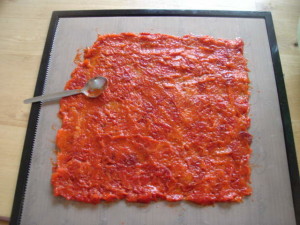
Rose hip leather. Photo by Wild Food Foraging.
Rose Hip Leather
Prep Time: 1 hour
Cook Time: 30 minutes
Total Time: 1 hour, 30 minutes
Ingredients:
- 4 cups (1 Litre) of rose hips
Preparation:
Just after a frost is the best time to gather rose hips. Snap off the tails as you pick,or later when you reach home. Spread the hips out on a clean surface and allow to dry partially. When the skins begin to feel dried and shriveled, split the hips and take out the large seeds — all of them. If you let the hips dry too much, it will be difficult to remove the seeds. If not dry enough, the inside pulp will be sticky and cling to the seeds. After the seeds are removed, allow the hips to dry completely before storing or they will not keep well. Store in small, sealed plastic bags. These will keep indefinitely in the freezer or for several months in the refrigerator. They are packed with vitamin C and are good to munch on anytime you need extra energy…or a moderately sweet nut-like “candy.”
Making Puree:
Use soft ripe rose hips (the riper they are, the sweeter they are). It takes about 4 cups (1 Litre) of rose hips to make 2 cups (480 ml) of puree. Remove stalks and blossom ends. Rinse berries in cold water. Put them into a pan and add enough water to almost cover. Bring to a boil and simmer 10 to 15 minutes. Press through a sieve or strainer. All that does not go through the sieve is placed in the pan again. Add a little water, enough to almost cover, if you want a thicker puree, add slightly less. This time heat but do not boil so vigorously. This will dissolve a little more of the fruit so that it will go through the sieve. Press again and then repeat the process one more time. By now, most of the fruit should have gone through the sieve leaving only seeds and skin to discard.
Drying Puree:
Line a cookie sheet, 12 by 17 inches (30 by 42 cm), with plastic wrap. This size cookie sheet holds approximately 2 cups (480ml) of puree. Spread puree or fruit leather evenly over the plastic but do not push it completely to the sides. Leave a bit of plastic showing for easy removal. Place on a card table or picnic table in the hot sun to dry. If the plastic is bigger than the cookie sheet and extends up the sides, anchor it with clothes pins so it will not flop down and cover the edges of the leather. Puree should dry in the sun six to eight hours.
Recipe Source: Cooking Alaskan By Alaskans (Alaska Northwest Books)

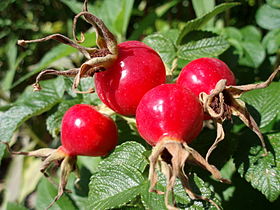
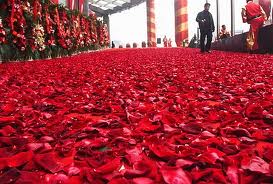
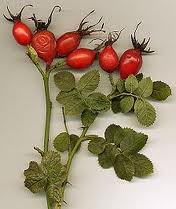

I noticed in the above article about edible roses you did not include the Olympiad Rose, a/k/a the macauck rose. is this flower edible? if so, do you recommend it??
thank you, Cindy
I did not list it because it is a hybrid. While it is probably as useable as other roses I do know know that for certain.
For the rose hip leather, do we skip the tedious sounding deseeding project? With the straining, it seems unnecessary…..
Is the cookie sheet size critical? Whatever cookie sheets that we have here on the ranch in eastern Connecticut are the new fangled type with no sides…hmm, wonder if a baking pan would work…how thick should the puree be?
Assuming the invasive Rosa multiflora species will work, I may just make this a little project here…..red is the color of the season….just gathered a bunch of hips post-frost and pre-wintry mix precipitation….those thorns allowed me to gather probably about the right amount….more could be had but the weather outside is predicted to turn frightful…perhaps I should visit Florida soon!
Do you ever return to Jolly ole’ New England for classes, etc?
Thanks for such a great website!
Edna
The hair on the seeds is the original itching powder. If made with unstrained hits you might get what the Aboriginals call “itchy bottom disease.” Puree should be pea soup thickness.
I am curious. Is there a non-edible rose hip? I have roses but do not know what kind they are???
If it is a true rose the hips should be usable.
Very interesting article, can I publish it on this site? http://flowerdeliveryuae.com
With credit, yes.
Thank you Green Deane for your informative website!
I am wondering if rose hips have any non-edible look alikes.
Regards,
Jennifer
There are quite a few related edible fruits that look similar… Hawthorn fruit is a good example. I can’t think of an non-edibles ones.
Hi Deane. Great article!
I was wondering, are the leaves edible? There is no mention of them here, and it is hard to find much information on the leaves.
Generally speaking no. It’s a family that has proto-cyanide in seeds and leaves and stuff like that. I have dozens of descriptions regarding edible parts of plants in this genus and none include leaves. Peeled young shoots are eaten but not leaves.
what do roses eat
Plants, unlike animals, make their own food.
I made the most delectable rose hip jelly with rose hips I foraged on my property in northern California. It is delisicious and purifying.
Just wondering if there was a site that would tell me different varieties of roses and what they taste like. I’ve seen a bunch of sites saying different colors make different flavors and darker colors have more flavor, but I’m looking for a rose with a stronger sweet flavor to grow with my daughter in her garden.
What eats Cherokee Roses?
Rose blossoms are edible.
Are the flowers of a rose tree true roses and are they edible?
I’ve been nibbling on rose hips since I was little (mostly rosa multiflora which grows everywhere here) but the other day as I was harvesting I ate a couple small handfuls and later had some stomach upset. I’ve seen various places referencing them causing nausea, vomiting, and diarrhea for some people but haven’t been able to find any more detailed info on that. Is it an allergic reaction or can eating too many fresh just be harsh on the stomach? Would this still be a problem strained and boiled in a syrup or jam?
It might be the seeds, or the hair on the seeds.